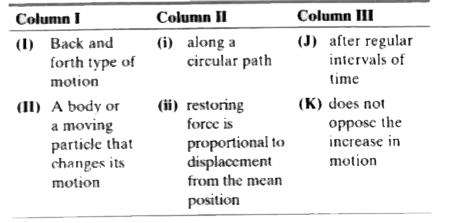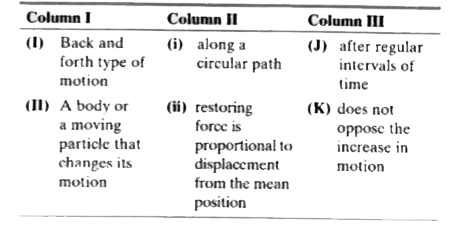List any two characteristics of simple harmonic motion.
To answer the question regarding the characteristics of simple harmonic motion (SHM), we can summarize the key points as follows:
1. Definition of Simple Harmonic Motion (SHM):
- Simple Harmonic Motion is a type of periodic motion where an object oscillates about a mean position.
2. Characteristic 1: Acceleration is Proportional to Displacement:
- In SHM, the acceleration of the object is directly proportional to its displacement from the mean position and is always directed towards that mean position. Mathematically, this can be expressed as:
a=−k⋅x
where a is the acceleration, k is a positive constant, and x is the displacement. The negative sign indicates that the acceleration acts in the opposite direction to the displacement.
3. Characteristic 2: Oscillatory Motion:
- SHM is inherently oscillatory, meaning that the motion repeats itself after a fixed interval of time called the time period. This oscillation is periodic, and the object moves back and forth around the mean position.
Final Answer:
1. The acceleration of the object is proportional to the displacement from the mean position and acts in the opposite direction.
2. The motion is oscillatory and periodic, meaning it repeats itself in a regular time interval.
---
- Simple Harmonic Motion is a type of periodic motion where an object oscillates about a mean position.
- In SHM, the acceleration of the object is directly proportional to its displacement from the mean position and is always directed towards that mean position. Mathematically, this can be expressed as:
a=−k⋅x
where a is the acceleration, k is a positive constant, and x is the displacement. The negative sign indicates that the acceleration acts in the opposite direction to the displacement.
- SHM is inherently oscillatory, meaning that the motion repeats itself after a fixed interval of time called the time period. This oscillation is periodic, and the object moves back and forth around the mean position.
1. The acceleration of the object is proportional to the displacement from the mean position and acts in the opposite direction.
2. The motion is oscillatory and periodic, meaning it repeats itself in a regular time interval.
Topper's Solved these Questions
Similar Questions
Knowledge Check
- Question 1 - Select One or More
In simple harmonic motion
APotential energy and kinetic energy may not be equal in mean position.Bpotential energy and kinetic energy may be equal in extreme positionCpotential energy may be zero at extreme positionDkinetic energy plus potential energy oscillates simple harmonically. - Question 2 - Select One
In a simple harmonic motion
Athe potential energy is always equal to the kinetic energyBthe potential energy of is never equal to the kinetic energyCthe average potential energy in any time interval is equal to the average kinetic energy in that time intervalDthe average potential energy is one time period is equal to the averge energy is this period - Question 3 - Select One or More
In a simple harmonic motion
Athe maximum potential energy equals the maximum kinetic energyBthe minimum potential energy equals the minimum kinetic energyCthe minimum potential energy equals the maximum kinetic energyDthe maximum potential energy equals the minimum kinetic energy.
In the given table, Column I gives type of motion, Column II gives the path traced and Column III gives other characteristic of the motion.


Choose the combination that defines the characteristics of simple harmonic motion.View SolutionIn the given table, Column I gives type of motion, Column II gives the path traced and Column III gives other characteristic of the motion.


Choose the combination that defines the characteristics of simple harmonic motion.View SolutionWhat are the two basic characteristics of a simple harmonic motion?
View SolutionWhat are the two basic characteristics of a simple harmonic motion?
View SolutionWhich of the following is not characteristics of simple harmonic motion?
View Solution

